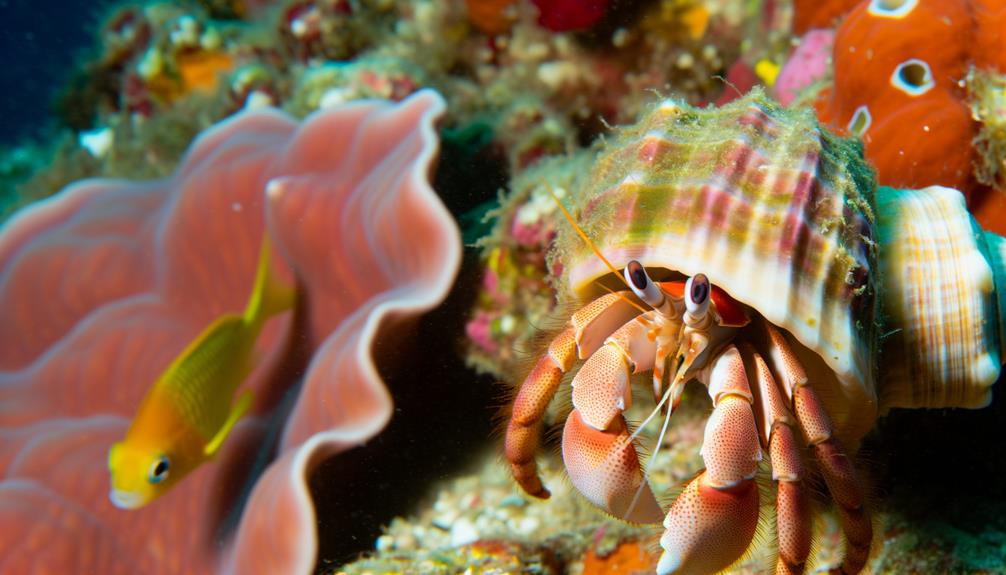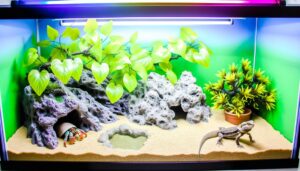Do Hermit Crabs Have Mouths?
Hermit crabs show behaviors and physiological responses indicating they have feelings. They meticulously select shells, establish social hierarchies, and exhibit stress responses to environmental changes.
Their advanced sensory systems aid in these activities. Studies have demonstrated elevated heart rates and stress hormones in response to threats, suggesting emotional capacity.
Social interactions are pivotal; isolation can increase stress and decrease health. Research indicates they possess pain perception and memory retention, underscoring their complex nature.
To fully understand the depth of their emotional experiences, further exploration into their behaviors and social needs is necessary.

Key Takeaways
- Hermit crabs demonstrate a range of emotions, indicating they do experience feelings.
- Pain perception in hermit crabs has been documented through scientific studies.
- Elevated heart rates and stress hormones are observed in response to threats.
- Social interactions and group living significantly impact their well-being and stress levels.
- Hermit crabs show memory retention and learning capabilities, suggesting cognitive functions related to feelings.
Understanding Hermit Crab Behavior
To understand hermit crab behavior, you need to observe their interactions with their environment and each other. These crustaceans exhibit complex behaviors like shell selection, social hierarchy, and foraging. When selecting a shell, hermit crabs demonstrate meticulous inspection and decision-making skills, which indicates cognitive processing.
They establish social hierarchies, often engaging in shell fights or rituals that determine dominance. By observing these behaviors, you can infer their social structures and individual roles within a group.
Additionally, their foraging patterns reveal adaptive strategies to find food efficiently. Evidence suggests hermit crabs engage in cooperative behaviors, like forming 'vacancy chains' for shell exchange, promoting collective well-being.
Understanding these behaviors can help you better care for and support these fascinating creatures.
Sensory Perception in Hermit Crabs
Hermit crabs possess a sophisticated set of sensory organs that enable them to interact effectively with their environment. Their compound eyes provide acute vision, allowing them to detect movement and navigate their surroundings.
Antennules, equipped with chemosensory cells, help hermit crabs identify food, mates, and potential threats through chemical signals in the water. Additionally, their statocysts, located near the antennae, allow them to sense gravity and maintain equilibrium.
These sensory capabilities are vital for their survival, aiding in foraging, predator avoidance, and social interactions. By understanding these mechanisms, you can better appreciate the complex ways hermit crabs experience their world, underscoring the importance of providing an enriched environment that caters to their sensory needs.
Stress Responses in Hermit Crabs
Numerous studies have shown that hermit crabs exhibit distinct stress responses when exposed to adverse environmental conditions. You'll observe that changes in temperature, humidity, and shell availability trigger physiological and behavioral adaptations. For instance, a rise in temperature can increase their metabolic rate, leading to dehydration risks.
Research demonstrates that hermit crabs engage in shell-switching behavior more frequently under stress, indicating a search for ideal living conditions. Additionally, elevated stress levels often result in reduced feeding and increased hiding behaviors, which serve as coping mechanisms.
Social Interactions and Loneliness
Social interactions play a vital role in the overall well-being of hermit crabs, as evidenced by their complex social behaviors and susceptibility to loneliness. When you observe hermit crabs, you'll notice they often engage in shell exchanges, a behavior indicating social cooperation. They also form groups, known as aggregations, for protection and resource acquisition.
Loneliness in hermit crabs can lead to increased stress and decreased health, highlighting their need for companionship. To guarantee their well-being, you should consider housing them in groups rather than isolation. Facilitating social interactions can enhance their quality of life, demonstrating that even these small creatures benefit from community, much like humans.
Scientific Studies and Findings
Research studies have illuminated the complex emotional lives of hermit crabs, providing robust evidence that these creatures experience a range of feelings. Scientists have conducted various experiments to understand their emotional responses. Through these investigations, several findings have emerged:
- Pain Perception: Hermit crabs exhibit behaviors indicative of pain, such as grooming and avoiding damaged shells.
- Stress Response: Elevated heart rates and stress hormones have been measured in crabs exposed to predatory threats.
- Social Behavior: Crabs demonstrate social hierarchies and exhibit signs of distress when isolated from their groups.
- Learning and Memory: Hermit crabs can learn to avoid adverse stimuli, showing they possess memory capabilities.
These scientific findings underscore the importance of treating hermit crabs with empathy and consideration in both research and care practices.
Conclusion
Imagine hermit crabs as tiny sailors charting the vast ocean of life. Their behavior, sensory perception, stress responses, and social interactions are the compass guiding their journey.
Scientific studies show they experience stress and social needs, hinting at a deeper emotional world. So, while we can't fully decode their inner seas, evidence suggests these small mariners have feelings, steering their way through existence just like us, guided by unseen currents of emotion.






